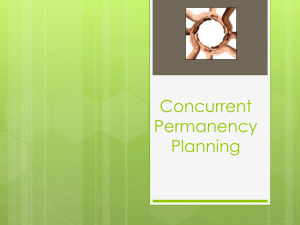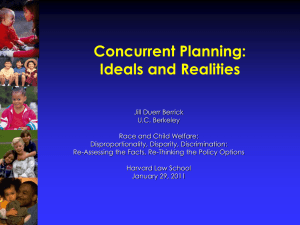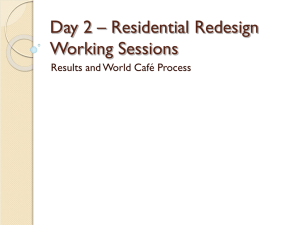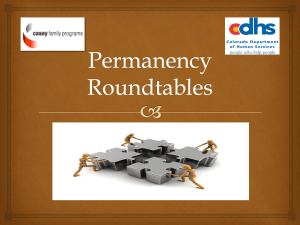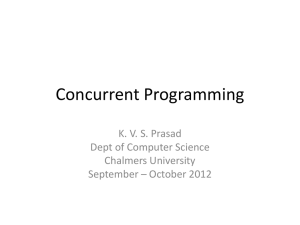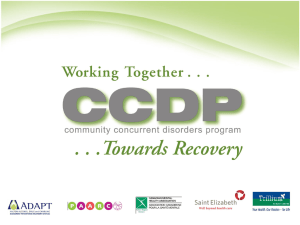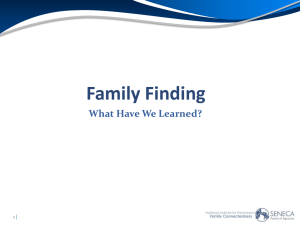Resources - National Resource Center for Permanency and Family
advertisement
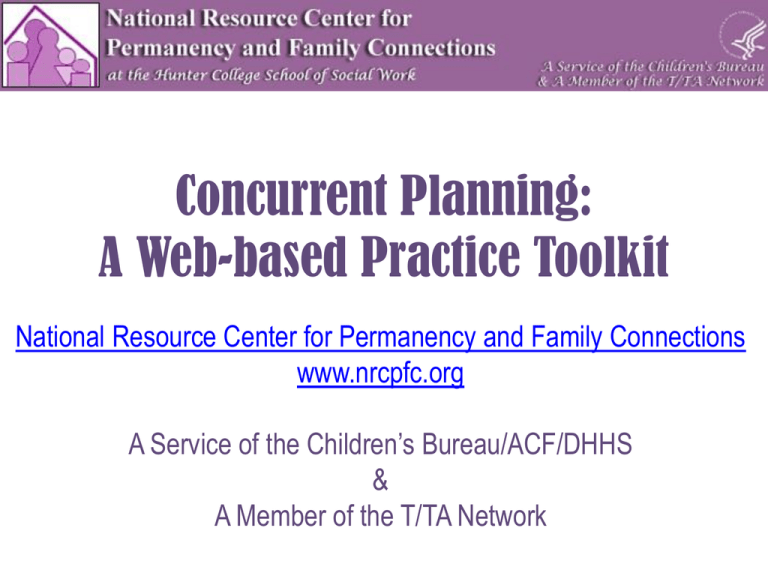
Concurrent Planning: A Web-based Practice Toolkit National Resource Center for Permanency and Family Connections www.nrcpfc.org A Service of the Children’s Bureau/ACF/DHHS & A Member of the T/TA Network An Overview of Concurrent Planning NRCPFC defines concurrent planning as: A process of working towards one legal permanency goal (typically reunification) while at the same time establishing and implementing an alternative permanency goal and plan that are worked on concurrently to move children/youth more quickly to a safe and stable permanent family (Permanency Roundtable Project, 2010). History of Concurrent Planning In the late 1960s and 1970s, Irmgard Heymann and her colleagues, working in Chicago, first formulated the concept of concurrent planning although they did not label it as such. Throughout the 1970s in communities across the US, child welfare caseworkers began making legal-risk or pre-adoptive placements when reunification seemed unlikely. Adoption Assistance and Child Welfare Act of 1980, sparked many states to develop permanency planning approaches, although most of these approaches involved sequential planning. If reunification efforts failed, they explored adoption or other permanency options. The Adoption and Safe Families Act of 1997 • The law states that reasonable efforts to place a child for adoption or with a legal guardian may be made concurrently with reasonable efforts to reunify. • The law further requires that for children who have been in foster care for 15 of the most recent 22 months, the state must file a petition to terminate parental rights unless certain exceptions apply. Goals of Concurrent Planning • To promote safety, permanency, well-being of children/youth • To achieve timely permanency • To reduce the number of moves for children and youth • To continue significant relationships Benefits of Concurrent Planning for Children and Youth: • Fewer placements while in foster care when children/ youth are placed with resource families who support reunification and relative placement, yet stand ready to be the child/youth’s permanent family should such efforts not be successful • Earlier permanency through reunification or another permanency option • Greater opportunities to benefit from all the caring adults in their lives as resource families and birth parents jointly work together to meet the child/youth’s needs Barriers to Successful Concurrent Planning: • • • • • • High caseloads and frequent staff turnover Lack of understanding of concurrent planning by Courts (including judges, citizen panels, attorneys, GALs and CASAs) Lack of understanding of concurrent planning by private providers of family services Lack of placement resources Lack of meaningful parent-child visitation Insufficient time for case managers to support resource parents Concurrent Planning Toolkit: Resources • Organizational Self Study: This self study assessment tool can be used to review concurrent planning policies and practices. The tool is designed to review overall administrative policies, strengths and challenges in implementing concurrent planning and to identify training and technical assistance needs. • Glossary of Concurrent Planning Terms • Bibliography of resources cited in the Toolkit Nine Core Components of Concurrent Planning: 1. Differential assessment 6. Setting clear time lines for and prognostic case permanency decisions review 7. Transparent written 2. Full disclosure to all agreements and participants in the case documentation planning process 8. Committed collaboration 3. Family search and between child welfare, the engagement courts, service providers 4. Family group 9. Specific recruitment, conferencing/teaming training, and retention of dual licensed resource 5. Visiting between family & families. child/youth 1. Differential assessment and prognostic case review: - - Individualizing our understanding of the individual, family or group in the context of their present circumstances, past experiences, and potential for future functioning. Deepening our family-centered understanding of the child in the context of family, culture, and community. Resources: Arizona’s Reunification Prognosis Assessment Guide This assessment guide is used to identify children in need of concurrent planning. The guide provides a list of conditions, designated “Poor Prognosis” indicators, which make timely reunification difficult or unlikely. The completion of the Reunification Prognosis Assessment occurs within 45 days of the child’s initial placement in out of home care. The caseworker completes the guide on both parents and in consultation with his/her supervisor. If any of the poor prognosis indicators are marked “yes”, a concurrent plan is recommended. At a minimum, concurrent case planning activities must be implemented. If a concurrent permanency goal is not identified, the Reunification Prognosis Assessment Guide is reviewed and updated at each case plan staffing Resources: Kansas’ Concurrent Planning Assessment Matrix This tool is designed to identity children in need of a concurrent planning placement based on a family assessment. The assessment is completed at the time the case is open. It seeks to balance a child’s need for permanency with recognition that parents have the capacity for growth and change and that reunification efforts continue in earnest. It is expected that some children living in concurrent planning resource families will reunify. The tool is ideal for team decision making as well as supervisory conference. 2. Full disclosure to all participants in the case planning process Full disclosure is a respectful, candid discussion that begins when a child is placed in foster care. Birth parents, extended family, children and youth, foster parents, relative caregivers, tribal representatives (when appropriate), attorneys, guardians ad litem, and service providers are all entitled to full disclosure. Resources: The Pennsylvania Child Welfare Training Program Concurrent Planning Full Disclosure Interview. Provides five key items to discuss during a full disclosure interview: rights, responsibilities, expectations, the effect of out of home placement on the child and the paths that a parent may take: work actively with the agency; withdraw, disappear, or sporadically appear so that no service plan can get going; take an adversarial stance; or relinquish permanent custody. Resources: Minnesota Children and Family Services: Full Disclosure Statement about Concurrent Planning A template that Minnesota social workers review with and have parents sign that advise parents about concurrent permanency planning, the permanency timelines, and parents’ rights and responsibilities. 3. Family Search and Engagement Six step approach to Family Finding as outlined in Six Steps to Find a Family: A Practice Guide to Family Search and Engagement (FSE): 1. Setting the Stage 2. Discovery 3. Engagement 4. Exploration and Planning 5. Decision Making and Evaluation 6. Sustaining the Relationship(s) Resource: Family Search & Engagement: A Comprehensive Practice Guide (2008) Family Search & Engagement (FSE) is a set of practices designed to locate, engage, connect, and support family resources for youth. This manual is intended to support the implementation of these complex practices by providing both an identification of the issues and activities involved and a variety of practical tools to assist the practitioner in the day-to-day work. 4. Family Group Conferencing/Teaming Many states are implementing conferencing, as a key family engagement strategy that bring families together to meet with the child welfare agency, community providers and significant individuals in their lives who can support them in making the best decisions for their children. Two approaches used: Family Group Decision Making/Family Group Conferencing (FGDM) and Team Decision-making (TDM) Resource: Guidelines for Family Group Decision Making (FGDM) in Child Welfare American Humane, in partnership with the FGDM Guidelines Committee, released this landmark publication. They hope that these guidelines will not only facilitate greater understanding of FGDM, but will also promote solid practice in the U.S. and abroad. This publication covers topics such as: The FGDM Coordinator, Referral to FGDM, Preparation, Family Meetings, Follow-Up After Family Meetings, and Administrative Support. 5. Visiting between Family & Child/Youth While children/youth are in out-of-home care placements, it is important to maintain connections with their birth families. Parentchild visits are a key strategy to accomplish this and to work toward reunification. Resource: Child Protection Best Practices Bulletin. Parent-Child Visitation. Provides information on current and best practices in parent-child visitation 6. Setting clear time lines for permanency decisions ASFA limits the amount of time a child can be in the foster care system prior to being placed in a permanent home. ASFA requires permanency hearings be held for children no later than 12 months after they enter foster care (6 months earlier than the prior law). ASFA also requires, in most cases, that Termination of Parental Rights be initiated for any child who has been in state custody for 15 out of the most recent 22 months. Resources: Iowa Department of Human Services. (2008). Concurrent Planning Checklist. Provides time frames for all key concurrent planning activities Kansas Department of Social and Rehabilitative Services. (2005). Case Review Timelines. Sets out the timelines for administrative, court and desk reviews in achieving permanency. Resources: Missouri Department of Social Services. (2009). Child Welfare Manual: Components of Effective Concurrent Planning The list of components includes: front loading of services that provides reasonable efforts and attempts to get the family engaged early; and effective and timely court hearings with firm timelines for permanency decision making; during which time, documented steps are taken to achieve reunification and an alternative permanency option. 7. Transparent written agreements and documentation. • The agency and the parents should document in a written agreement the steps that must be taken for the child to return home. The agreement should make clear what is expected of the parents and what the agency will do. • The case plan should specify both short- and longterm goals and provide service linkages, such as connection of parents to mental health services, drug treatment, and family supports. Resources: Iowa Department of Human Services: Child Welfare Case Planning Procedures (2007). Describes required practices for developing the concurrent plan and documenting case activities and progress. Wyoming Department of Family Services. (2004). Concurrent Planning Handbook. Appendix C provides a case file documentation checklist. 8. Committed collaboration between child welfare, the courts, and service providers: • Creating a teaming approach with planned contact between birth and foster parents can result in children returning home sooner, having more stable placements, experiencing better emotional development, and being more successful in school. • Icebreaker meetings or visits represent the first step to integrating the birth family into their child’s life while in out of home care. Resources: New Mexico Concurrent Planning: A Guide for Judges, Attorneys, and Others Working with Children & Families (2005) Designed for judges, attorneys, and others working with children and families in New Mexico, this guide explains concurrent planning in child welfare. It is a process that allows the New Mexico Children, Youth, and Families (CYFD) to provide reunification services to the child and the family at the same time as CYFD works on an alternative plan, such as adoption, permanent guardianship, or placement with a fit and willing relative. It is explains why New Mexico adopted concurrent planning, operating principles of concurrent planning, how cases are selected for concurrent planning and how such homes are established, and the roles of judges, advocates, and youth service workers, in implementing concurrent planning. Resources: Bridging the Gap: Families Working Together – A Northern Virginia Foster Care and Adoption Initiative Bridging the Gap is the process of building and maintaining relationships and communication between the birth families involved in a youth’s life, or between the foster and adoptive families, with the goal of supporting family reunification or another permanency plan. This work started in 2006 and has been a process that evolved over time. The implementation of this best practice is a true collaboration between the private/public agencies in Northern Virginia. 9. Specific recruitment, training, and retention of dual licensed resource families. These resource families need initial as well as ongoing training and support. Effectively facilitating the relationship between the birth family and the foster family is essential. This relationship can enhance placement stability as well as expedite permanency. Resources: Handbook for Training Concurrent Permanency Planning Resource Parents in Minnesota This publication from the North American Council on Adoptable Children contains exercises that help program managers and social workers prepare concurrent permanency planning resource parents to facilitate two contrasting permanency planning outcomes. By Mary Ford, M.S.W. Practice Guide for Concurrent Permanency Planning. Minnesota Department of Human Services This guide promotes best practice in permanency planning by describing a step-by-step approach to working with families in the child welfare system Resource: Wyoming Concurrent Planning Handbook This handbook, prepared with the assistance of the NRCPFC, describes the model of concurrent permanency planning adopted statewide, and provides guidance to caseworkers throughout the process as well as information on recruitment and retention of resource families. Questions and Discussion Next Steps For further information, contact Dr. Gerald P. Mallon, DSW Professor & Executive Director gmallon@hunter.cuny.edu
